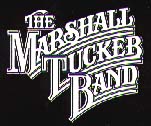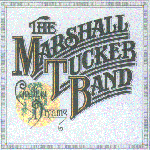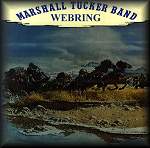

One of the most special shows Marshall Tucker ever put on was their performance at Jimmy Carter's Inaugural Ball in 1977 with Guy Lombardo, Sea Level and Charlie Daniels.
"There were ten thousand people wearing cocktail dresses and wearing black ties. They were drinking out of their champagne glasses and we were up there playing 'Take The Highway.' I kept thinking, 'Don't pinch me now. Don't wake me up,'" Riddle laughs. "My mother met Guy Lombardo, the President, the First Lady and cher all in about ten seconds time."
By this time in their career, the band and Hornsby had developed a consistent process for recording albums. Much of the time, Toy would come into the studio with a handful of songs that, more than likely, hadn't been worked up by the band. Since Marshall Tucker and Hornsby didn't do any real pre-production rehearsing, the songs were worked out in the studio.
This approach certainly made the performances on the album have a freshness. Nevertheless, it also helps explain why many of their songs would gradually evolve into dramatically different arrangement as they matured over months of touring.
"Most of the time, we would go into the studio and pretty much learn the songs there. Then the song would develop on the stage," says Riddle. "Sometimes, Toy might have a specific musical idea, but usually he was real generous about his tunes. He trusted us and liked our input. If Toy had a musical idea, everybody would seriously tune in, because he was so gifted."
"Those records weren't really thought out. The music was just what we felt good playing," adds George McCorkle. "Toy had this knack of writing music that worked wel for that group of guys. He always told me that we interpreted his thoughts very well."
"For the first album, the band had those songs in their repertoire for quite a while, and they had been playing them live," Paul Hornsby points out. "A lot of times later on, the band might have heard some of the songs on acoustic guitar, but they usually hadn't worked them up. They were never ones to sit in a warehouse and do pre-session rehearsals."
"When your success is measured by your last record, and everyone of them seemed to be a hit, there was no planning and they were expecting a lot out of it," Hornsby continues. "I would told that the band was taking off two months to make a record and 'go and do some fantastic.' Jesus Christ! I'd be gnawing my fingers off to my elbows, because it was all on Toy, because he wrote 99 per cent of all the good material."
"The only song that was an exception to that process was when I was in a dressing room at a gig in Atlanta. We were getting ready to do the next album in about a week, and I ask Toy if he had any good songs ready. He said, 'Listen to this one,' and started strumming and singing and everybody in the dressing room started singing "Heard It In A Love Song." I said, ' That will be your first real hit single. 'And it was."
"Hearing that song in the dressing room just floored me. It had "hit record" written all over it and I was smiling all over the place," recalls Hornsby. "We worked towards that song being the Top Forty single from the album. It had all the right ingredients and we tried to put all the right licks and hooks in the right places."
The hard work paid off and "Heard It In A Love Song" became the band's biggest hit, peaking at #14 in the spring of 1977. The album, from which that sing came, reached #23 on the Billboard Album charts and became Marshall Tucker's second platinum album.
"The next recording I did of them was a European tour, which came right on the heels of that album's completion," includes Hornsby. "Those tracks were supposed to go for a projected live album that was never released."
 After the huge success of "Heard It In A Love Song" and the Carolina Dreams album, the band began to subtly unravel. This was partiially due to different directions of interest each member was beginning to pursue, but the element that clouded the sensitivity and judgment of many of the band members was substance abuse.
After the huge success of "Heard It In A Love Song" and the Carolina Dreams album, the band began to subtly unravel. This was partiially due to different directions of interest each member was beginning to pursue, but the element that clouded the sensitivity and judgment of many of the band members was substance abuse.
Politics between the band and the label also began to strain. The first obvious casualty during this evolution was the demise of Paul Hornsby as producer.
During the late spring of 1978, the Stewart Levine-produced Together Forever hit the stores and, on the strenght of the band's hit credibility, reached #22 on the Billboard Album charts. It also went gold.
Unlike the band's previous album covers that featured arty Wild West theme paintings, Together Forever sported the first group picture of the band. In a sense, the effect underscored the band's sense of unity and permanence.
"On that album cover, we were pissed off, but we were really united," Riddle remarks. "You can tell we were very determined to be together forever. That wasn't some trite thing on our part. We really felt like that then."
"We really thought that we would be together forever at the time. We were very content with what we were doing in life," McCorkle underscores.
Levine, whose production credits included The Jazz Crusaders, Joe Cocker and The Dixie Dregs, took the band to Criteria Studio in Miami.
The opening track, "I'll Be Loving You," was a fine Marshall Tucker track, as was "Dream Lover."
Together Forever would be The Marshall Tucker Band's final album of new material for the Capricorn label. In 1978, a Greatest Hits was released that, while not reaching the Top Forty Album chart, also went gold.
The group moved to the Warner Brothers label and released five more albums.
On April 28, 1980, Tommy Caldwell passed away from injuries sustained in a car wreck almost a week earlier. The effect of Caldwell's death took a lot of the wind out of the band's sails, but Marshall Tucker continued on, enlisting old Toy Factory bassist Franklin Wilkie to fill the vacancy.
"It was a real turning point for the band," says McCorkle. "We all wanted to continue playing, but there was a big void there."
"When you are a musician on your own stage, and you're playing and locking into a groove with these five other guys, there is no other high in the world that compares to it. Very few people on the planet get to experience what that truly is like," McCorkle explains. "When you get use to locking into that awesome power and then, all of a sudden, one part of that power is gone, it is hard to get it back."
In June of 1984, Toy Caldwell, George McCorkle and Paul Riddle called it quits, due to internal band tensions brought about by conflicting agendas, continued substance abuse and general fatigue.
Toy Caldwell eventually pursued a solo career and released one album, Toy Caldwell Band, in 1992 to good notices. Unfortunately, Caldwell passed away suddenly from a heart attack on February 25, 1993. On that day, the music world lost a considerable songwriter and one of it's finest guitarists.
Today, George McCorkle is a successful songwriter in Nashville. Paul Riddle lives in Spartanburg and owns a drum shop and a drum stick company called The Carolina Stick Company. Doug Gray and Jerry Eubanks continue to carry on under the Marshall Tucker banner to audiences all over North America.
"The way I look at it, is the Marshall Tucker Band consisted of six players all with a very different tastes and musical backgrounds," offers Gray. "It is American music, because it takes all those cultures and music that come from within the South or across the country. When you put those elements together, you got a Marshall Tucker sound."
"The Marshall Tucker Band was something that I did out of pure love for what it was that we did," McCorkle concludes. "That is what it started out to be and, if you listen to the music close enough, you will definitely understand that we loved each other and we loved what we did. I don't think anybody ever loved what we did more than we did and I feel really blessed to have been involved in that small part of history."
|
This Marshall Tucker Band Site owned by Simple Man. |
 |
| Previous | Next |